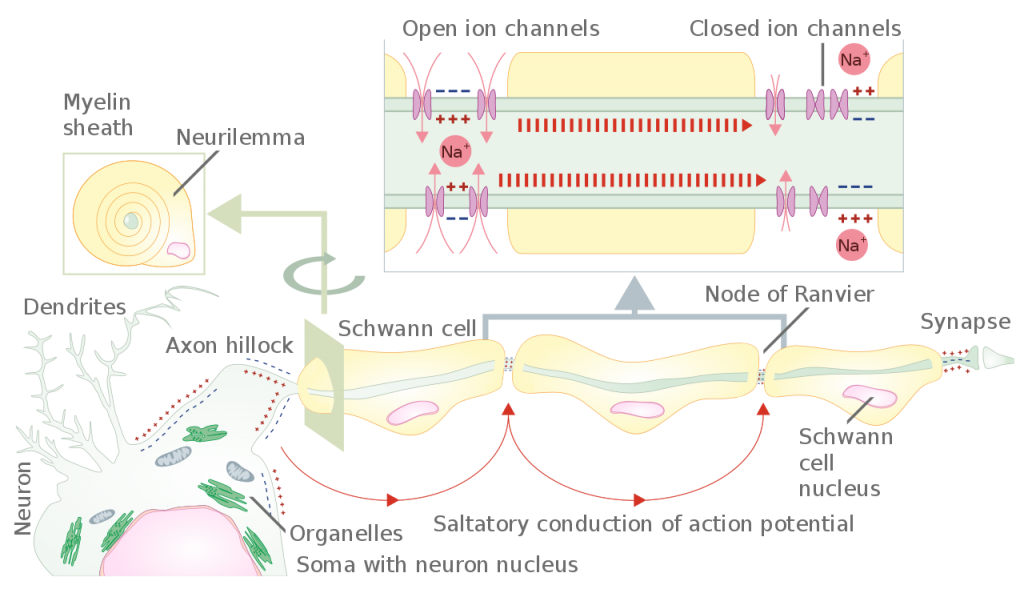
Physiology
Basic Cellular
Regarding conduction of nerve impulses, which of the following statements is CORRECT:
Answer:
An action potential is a self-propagating response, successive depolarisation moving along each segment of an unmyelinated nerve until it reaches the end. It is all-or-nothing and does not decrease in size. Conduction in myelinated fibres is much faster, up to 50 times that of the fastest unmyelinated nerve. Myelinated fibres are insulated except at areas devoid of myelin called nodes of Ranvier. The depolarisation jumps from one node of Ranvier to another by a process called saltatory conduction. Saltatory conduction not only increases the velocity of impulse transmission but also conserves energy for the axon because depolarisation only occurs at the nodes and not along the whole length of the nerve fibre. Larger diameter neurones, especially those that are myelinated, conduct impulses faster than small diameter neurones, due to lower internal resistance and saltatory conduction.Propagation of Action Potentials
Physiology / Basic Cellular / Action Potential
Last Updated: 26th July 2024
An action potential is a self-propagating response, successive depolarisation moving along each segment of an unmyelinated nerve until it reaches the end. It is all-or-nothing and does not decrease in size.
Conduction in myelinated fibres is much faster, up to 50 times that of the fastest unmyelinated nerve. Myelinated fibres are insulated except at areas devoid of myelin called nodes of Ranvier. The depolarisation jumps from one node of Ranvier to another by a process called saltatory conduction.
Saltatory conduction not only increases the velocity of impulse transmission but also conserves energy for the axon because depolarisation only occurs at the nodes and not along the whole length of the nerve fibre.
Larger diameter myelinated nerve fibres conduct nerve impulses faster than small unmyelinated nerve fibres.

Saltatory Conduction. (Image by Helixitta (Own work) [CC BY-SA 4.0 , via Wikimedia Commons)
Report A Problem
Is there something wrong with this question? Let us know and we’ll fix it as soon as possible.
Loading Form...
- Biochemistry
- Blood Gases
- Haematology
| Biochemistry | Normal Value |
|---|---|
| Sodium | 135 – 145 mmol/l |
| Potassium | 3.0 – 4.5 mmol/l |
| Urea | 2.5 – 7.5 mmol/l |
| Glucose | 3.5 – 5.0 mmol/l |
| Creatinine | 35 – 135 μmol/l |
| Alanine Aminotransferase (ALT) | 5 – 35 U/l |
| Gamma-glutamyl Transferase (GGT) | < 65 U/l |
| Alkaline Phosphatase (ALP) | 30 – 135 U/l |
| Aspartate Aminotransferase (AST) | < 40 U/l |
| Total Protein | 60 – 80 g/l |
| Albumin | 35 – 50 g/l |
| Globulin | 2.4 – 3.5 g/dl |
| Amylase | < 70 U/l |
| Total Bilirubin | 3 – 17 μmol/l |
| Calcium | 2.1 – 2.5 mmol/l |
| Chloride | 95 – 105 mmol/l |
| Phosphate | 0.8 – 1.4 mmol/l |
| Haematology | Normal Value |
|---|---|
| Haemoglobin | 11.5 – 16.6 g/dl |
| White Blood Cells | 4.0 – 11.0 x 109/l |
| Platelets | 150 – 450 x 109/l |
| MCV | 80 – 96 fl |
| MCHC | 32 – 36 g/dl |
| Neutrophils | 2.0 – 7.5 x 109/l |
| Lymphocytes | 1.5 – 4.0 x 109/l |
| Monocytes | 0.3 – 1.0 x 109/l |
| Eosinophils | 0.1 – 0.5 x 109/l |
| Basophils | < 0.2 x 109/l |
| Reticulocytes | < 2% |
| Haematocrit | 0.35 – 0.49 |
| Red Cell Distribution Width | 11 – 15% |
| Blood Gases | Normal Value |
|---|---|
| pH | 7.35 – 7.45 |
| pO2 | 11 – 14 kPa |
| pCO2 | 4.5 – 6.0 kPa |
| Base Excess | -2 – +2 mmol/l |
| Bicarbonate | 24 – 30 mmol/l |
| Lactate | < 2 mmol/l |

